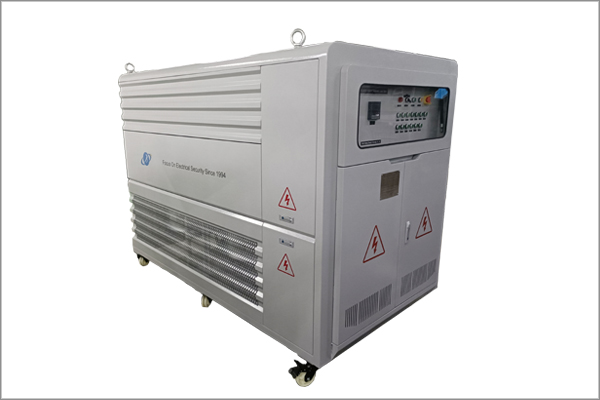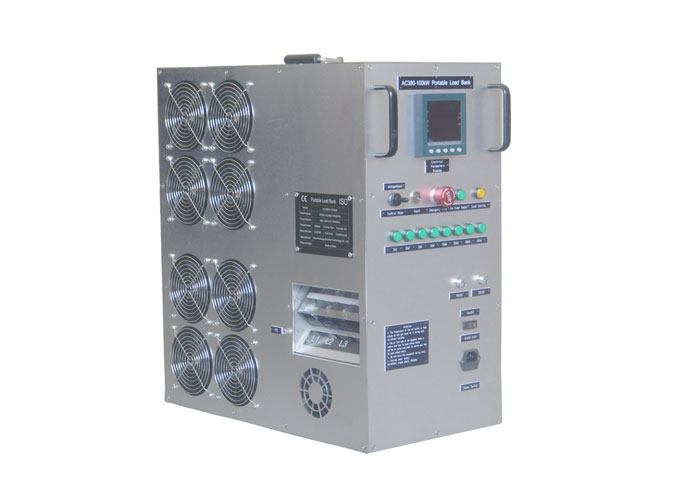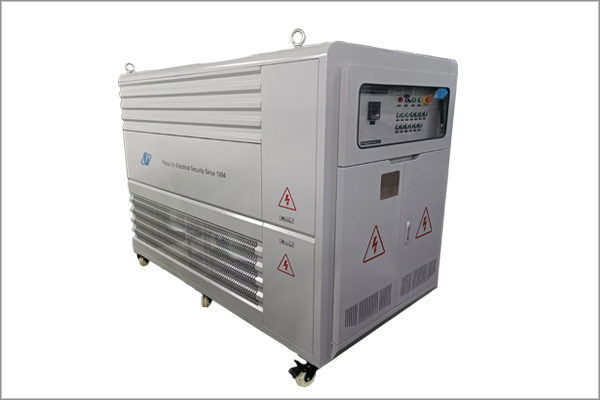The Specific Application of Resistive Load Banks in the Field of New Energy Power Generation
Time:2025-06-07
I. Solar Photovoltaic Power Station: Inverter Commissioning and System Stability Assurance
In solar photovoltaic systems, the direct current generated by the photovoltaic array needs to be converted into alternating current through an inverter before it can be connected to the grid or used by the load. The core role of the resistive load bank in this stage is as follows:
Inverter performance testing: By connecting to a resistive load bank, the equivalent resistance characteristics of the power grid are simulated to test the inverter's efficiency under different power outputs (such as verifying a conversion efficiency of over 95%), voltage/frequency stability (such as output voltage fluctuation range ≤±5%), and harmonic content (THD must be ≤5%). For instance, before the inverter leaves the factory, it needs to undergo full-load continuous operation tests through a resistive load bank to ensure that it does not overheat or have abnormal output during long-term loading.
Islanding effect protection verification: When the power grid is cut off, if the photovoltaic system fails to detect it in time and disconnect from the grid, it may form an "island", threatening the safety of maintenance personnel. The resistive load bank can simulate the load state after the power grid is cut off to test the islanding effect detection function of the inverter (for example, the response time of the active frequency offset method is ≤2 seconds).
Pre-grid connection commissioning of photovoltaic power stations: Before the power station is connected to the grid, gradually increase the load power through the resistive load bank (for example, from 20% of the rated power to 100%), observe the coordinated working state of the photovoltaic array and the inverter, and ensure that the system can stably output under different lighting conditions.
Ii. Wind Farms: Converter Debugging and Energy Conversion Optimization
In wind power generation, wind turbine units convert the variable-frequency alternating current generated by the generator into stable industrial frequency electricity through converters. The application scenarios of resistive load bankes include:
Converter load-carrying capacity test The output power of wind turbine units fluctuates significantly under different wind speeds (such as 3-25m/s). The resistive load bank can simulate the load changes throughout the full wind speed range to test the output stability of the converter under low wind speed (such as 5m/s, corresponding to 20% of the rated power), rated wind speed (12m/s), and high wind speed (20m/s, requiring current limiting protection). For example, at a wind speed of 10m/s, the converter needs to be verified through a resistive load bank that its output voltage fluctuation is ≤±3% and the frequency deviation is ≤±0.5Hz.
Fault ride-through capability verification: When the grid voltage drops sharply (such as to 20% of the rated value), wind turbine units need to have the "low-voltage ride-through" capability to avoid disconnection from the grid. The resistive load bank can be used in conjunction with a power grid simulator to simulate a voltage sag scenario, testing the reactive power compensation capacity of the converter during a fault (such as injecting 10% of the rated capacity reactive power into the grid) and its re-grid connection performance after recovery.
Cabin equipment heat dissipation test: When converters and other equipment operate under high load, they generate a large amount of heat. The full-load test of the resistive load bank can simultaneously monitor the temperature rise of the equipment (for example, the temperature of the IGBT module needs to be ≤85℃), verifying the effectiveness of the cabin heat dissipation system.
Iii. New Energy Microgrid: Energy Balance and Redundancy Management
In the microgrid composed of solar energy, wind energy and energy storage devices, the resistive load bank, as a "flexible energy dissipation component", undertakes the following functions:
Buffer regulation of intermittent power supply: When there is an excess of renewable energy generation (such as when wind power is large at night and the load is low), resistive load bankes are put into operation to consume the excess electricity (such as 100KW-level load), to prevent overcharging and damage to the energy storage battery, and at the same time maintain the stability of the microgrid frequency (such as controlled within 50±0.2Hz).
Load simulation in off-grid mode When the microgrid operates off-grid, it is necessary to simulate the power characteristics of different types of loads such as residential and industrial loads through resistive load bankes (such as resistive loads accounting for 70% and inductive loads accounting for 30%), and test the droop control strategy of the energy storage converter (PCS) (such as setting the voltage-frequency droop slope to 5%/10%). Ensure the load distribution accuracy when multiple power sources are used for coordinated power supply (such as the power distribution error of each power source ≤5%).
Black start test: After the entire microgrid system is powered off, a "black start" should be carried out through an energy storage device in conjunction with a resistive load bank. That is, the energy storage first supplies power to a low-power resistive load (such as 10kW), and then gradually connects to a larger load to verify the system's start-up sequence from no-load to full-load (such as start-up time ≤5 minutes) and stability.
Iv. Special Scenarios: Combined systems of new energy hydrogen production and energy storage
In the "photovoltaic/wind power + electrolytic water hydrogen production" system, the resistive load bank can be used to regulate the input power of the electrolytic cell: when the grid electricity price is low or there is an excess of renewable energy, the resistive load bank is connected in parallel with the electrolytic cell to consume the excess electricity (such as a 1MW-level load) and prevent reverse transmission from the grid. Meanwhile, by adjusting the load power to match the optimal working range of the electrolytic cell (such as a DC voltage of 300-400V and a current density of 2000A/m²), the hydrogen production efficiency is enhanced (such as hydrogen production per kilowatt-hour of electricity ≥5.5Nm³).
Through the above applications, the resistive load bank not only resolves the pain points of "intermittency and volatility" in new energy power generation, but also promotes the development of new energy systems towards high reliability and high grid compatibility through precise load simulation and energy management. If you need to know more about the technical details of a certain type of new energy scenario, you can inform us of your specific requirements at any time.
News Recommendation
-
 2024-09-11
2024-09-11TRIUMPH LOAD EXHIBITING AT Enlit Europe 2024 -BOOTH 7.H08
-
 2023-04-21
2023-04-21TRIUMPH LOAD EXHIBITING AT DATA CENTER WORLD GERMANY 2023-BOOTH F909
-
 2023-04-06
2023-04-06TRIUMPH LOAD EXHIBITING AT ELECTRIC POWER TECH KOREA 2023 – Booth G109
-
 2022-05-05
2022-05-05What is the role of ac load bank for power supply?
-
 2022-05-05
2022-05-05What is the role of the load bank?


